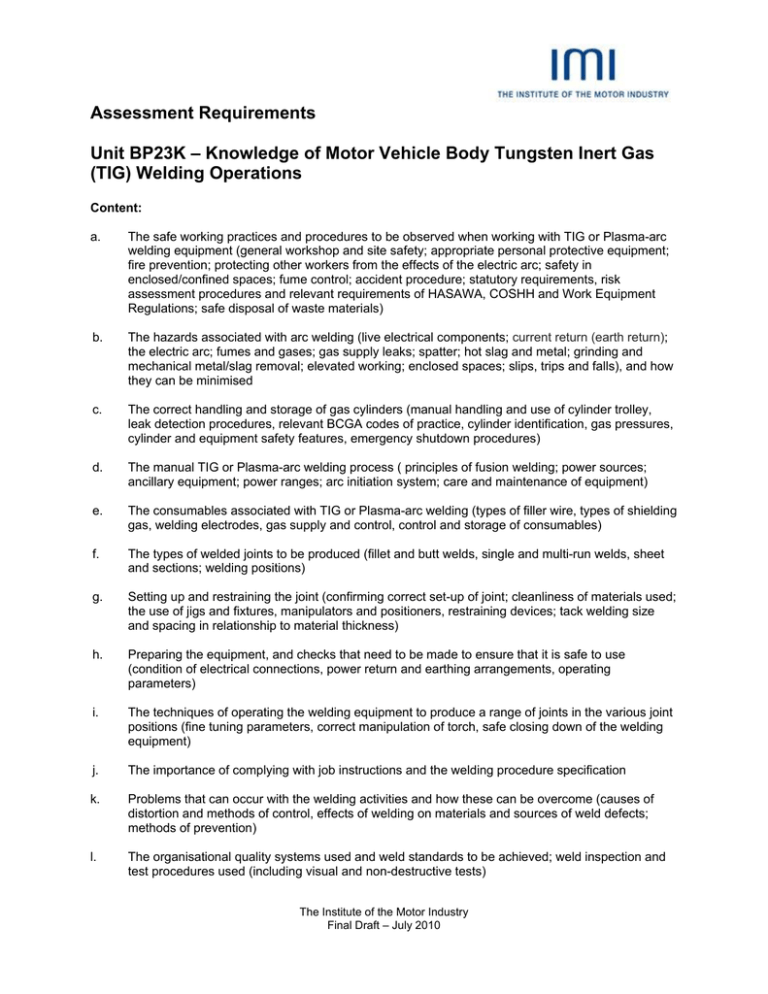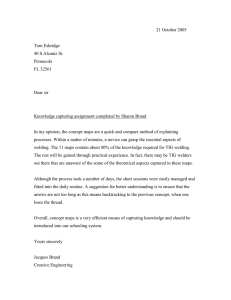BP23K - Institute of the Motor Industry
advertisement

Assessment Requirements Unit BP23K – Knowledge of Motor Vehicle Body Tungsten Inert Gas (TIG) Welding Operations Content: a. The safe working practices and procedures to be observed when working with TIG or Plasma-arc welding equipment (general workshop and site safety; appropriate personal protective equipment; fire prevention; protecting other workers from the effects of the electric arc; safety in enclosed/confined spaces; fume control; accident procedure; statutory requirements, risk assessment procedures and relevant requirements of HASAWA, COSHH and Work Equipment Regulations; safe disposal of waste materials) b. The hazards associated with arc welding (live electrical components; current return (earth return); the electric arc; fumes and gases; gas supply leaks; spatter; hot slag and metal; grinding and mechanical metal/slag removal; elevated working; enclosed spaces; slips, trips and falls), and how they can be minimised c. The correct handling and storage of gas cylinders (manual handling and use of cylinder trolley, leak detection procedures, relevant BCGA codes of practice, cylinder identification, gas pressures, cylinder and equipment safety features, emergency shutdown procedures) d. The manual TIG or Plasma-arc welding process ( principles of fusion welding; power sources; ancillary equipment; power ranges; arc initiation system; care and maintenance of equipment) e. The consumables associated with TIG or Plasma-arc welding (types of filler wire, types of shielding gas, welding electrodes, gas supply and control, control and storage of consumables) f. The types of welded joints to be produced (fillet and butt welds, single and multi-run welds, sheet and sections; welding positions) g. Setting up and restraining the joint (confirming correct set-up of joint; cleanliness of materials used; the use of jigs and fixtures, manipulators and positioners, restraining devices; tack welding size and spacing in relationship to material thickness) h. Preparing the equipment, and checks that need to be made to ensure that it is safe to use (condition of electrical connections, power return and earthing arrangements, operating parameters) i. The techniques of operating the welding equipment to produce a range of joints in the various joint positions (fine tuning parameters, correct manipulation of torch, safe closing down of the welding equipment) j. The importance of complying with job instructions and the welding procedure specification k. Problems that can occur with the welding activities and how these can be overcome (causes of distortion and methods of control, effects of welding on materials and sources of weld defects; methods of prevention) l. The organisational quality systems used and weld standards to be achieved; weld inspection and test procedures used (including visual and non-destructive tests) The Institute of the Motor Industry Final Draft – July 2010 m. Personal approval tests and their applicability to your work n. The extent of your own authority and whom you should report to if you have problems that you cannot resolve o. Reporting lines and procedures, line supervision and technical experts The Institute of the Motor Industry Final Draft – July 2010

